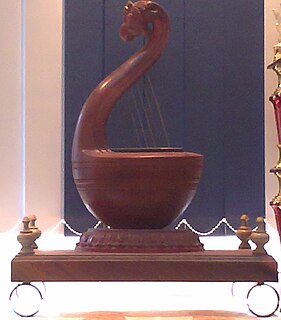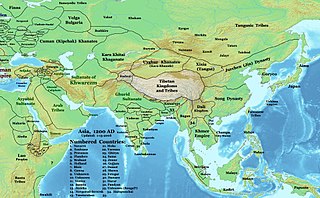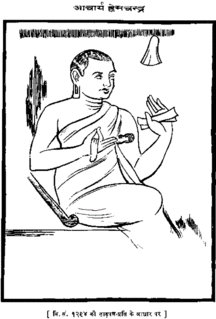The Prakrits are any of several Middle Indo-Aryan languages formerly used in India.

Carnatic music, Karnāṭaka saṃgīta, or Karnāṭaka saṅgītam, is a system of music commonly associated with southern India, including the modern Indian states of Andhra Pradesh, Telangana, Karnataka, Kerala, and Tamil Nadu, as well as Sri Lanka. It is one of two main subgenres of Indian classical music that evolved from ancient Hindu traditions, the other subgenre being Hindustani music, which emerged as a distinct form because of Persian or Islamic influences from Northern India. The main emphasis in Carnatic music is on vocal music; most compositions are written to be sung, and even when played on instruments, they are meant to be performed in gāyaki (singing) style.

Indian classical music is the classical music of the Indian subcontinent. It has two major traditions: the North Indian classical music tradition is called Bharatiya , while the South Indian expression is called Carnatic. These traditions were not distinct till about the 16th century. There on, during the turmoils of Islamic rule period of the Indian subcontinent, the traditions separated and evolved into distinct forms. Bharatiya music emphasizes improvisation and exploring all aspects of a raga, while Carnatic performances tend to be short and composition-based. However, the two systems continue to have more common features than differences.
Indian literature refers to the literature produced on the Indian subcontinent until 1947 and in the Republic of India thereafter. The Republic of India has 22 officially recognized languages.

A Tala, sometimes spelled Taal or Tal, literally means a "clap, tapping one's hand on one's arm, a musical measure". It is the term used in Indian classical music to refer to musical meter, that is any rhythmic beat or strike that measures musical time. The measure is typically established by hand clapping, waving, touching fingers on thigh or the other hand, verbally, striking of small cymbals, or a percussion instrument in the Indian subcontinental traditions. Along with raga which forms the fabric of a melodic structure, the tala forms the life cycle and thereby constitutes one of the two foundational elements of Indian music.

Kannada literature is the corpus of written forms of the Kannada language, a member of the Dravidian family spoken mainly in the Indian state of Karnataka and written in the Kannada script.

Telugu literature or Telugu Sahityam is the body of works written in the Telugu language. It consists of poems, novels, short stories, dramas and puranas. Telugu literature can be traced back to the early 10th century period followed by 11th century period when Mahabharata was first translated to Telugu from Sanskrit by Nannaya. It flourished under the rule of the Vijayanagara Empire, where Telugu was one of the empire's official languages.
A rasa literally means "juice, essence or taste". It connotes a concept in Indian arts about the aesthetic flavour of any visual, literary or musical work that evokes an emotion or feeling in the reader or audience but cannot be described. It refers to the emotional flavors/essence crafted into the work by the writer and relished by a 'sensitive spectator' or sahṛdaya or one with positive taste and mind.

The ancient Tamil music is the historical predecessor of the Carnatic music during the Sangam period 500 BCE - 200CE.

Hoysala literature is the large body of literature in the Kannada and Sanskrit languages produced by the Hoysala Empire (1025–1343) in what is now southern India. The empire was established by Nripa Kama II, came into political prominence during the rule of King Vishnuvardhana (1108–1152), and declined gradually after its defeat by the Khalji dynasty invaders in 1311.

Mysore literature in Kannada is a body of literature composed in the Kannada language in the historical Kingdom of Mysore in Southern India and written in the Kannada script. The writings date from the Kingdom of Mysore, which existed from around 1600 CE until the establishment of modern India in 1947. Many of the works of this literature written on religious themes are labeled Veerashaiva or Vaishnava in acknowledgment of the two faiths that gave form to the literature and fostered it until the advent of the modern era. Despite a gradual decline in the popularity of Jainism, authors devoted to the faith produced some works of merit. Secular themes dealing with a wide range of subjects were also written on. Kannada literature flourished for a short while in the court of the neighbouring kingdom of the Nayakas of Keladi whose territory was annexed by Mysore in 1763.

Vijayanagara literature in Kannada is the body of literature composed in the Kannada language of South India during the ascendancy of the Vijayanagara Empire which lasted from the 14th through the 16th century. The Vijayanagara empire was established in 1336 by Harihara I and his brother Bukka Raya I. Although it lasted until 1664, its power declined after a major military defeat by the Shahi Sultanates in the battle of Talikota in 1565. The empire is named after its capital city Vijayanagara, whose ruins surround modern Hampi, now a World Heritage Site in Karnataka.

Jain literature comprises Jain Agamas and subsequent commentaries on them by various Jain asectics. Jain literature is primarily divided between Digambara literature and Svetambara literature. Jain literature exists mainly in Magadhi Prakrit, Sanskrit, Marathi, Tamil, Rajasthani, Dhundari, Marwari, Hindi, Gujarati, Kannada, Malayalam, Tulu and more recently in English.

Odissi music (oṛiśī) is a genre of classical music in India originated from the eastern state of Odisha. Indian classical music has five significant branches: Avanti, Panchali, Odramagadhi, Hindustani and Carnatic. Of these, Odramagadhi exists in the form of Odissi music. Generally, Odissi is one of the classical dances of India performed with Odissi music. Odissi music was shaped during the time of Odiya poet Jayadeva, who composed lyrics meant to be sung. By the 11th century AD, folk music of Odisha in the form of Triswari, Chatuhswari, and Panchaswari was modified into the classical style. However, Odissi songs were written even before the Odia language developed. Odissi music has a rich legacy dating back to the 2nd century BCE, when king Kharavela, the ruler of Odisha (Kalinga), patronized this music and dance.
Manbhatt were Brahmin priests of south Gujarat (India) narrating stories called Akhyanas to the accompaniment of music played on copper-made water pitcher or large globular metal pot (man) having a narrow mouth and bloated mid-part, used for beats of rhythmic beating time as required. The manbhatt has been an important fixture in the religious lives of middle-class Gujaratis for several hundred years. Today, this once extremely popular art of story-telling is almost extinct.
Fagu, also spelled Phagu, is a genre of poetry in Old Gujarati language popular during early period of Gujarati literature.

Old Gujarātī, the ancestor of modern Gujarati and Rajasthani, was spoken by the Gurjars, who were residing and ruling in Gujarat, Punjab, Rajputana and central India. The language was used as literary language as early as the 12th century. Texts of this era display characteristic Gujarati features such as direct/oblique noun forms, postpositions, and auxiliary verbs. It had three genders, as Gujarati does today, and by around the time of 1300 CE, a fairly standardized form of this language emerged. While generally known as Old Gujarati, some scholars prefer the name of Old Western Rajasthani, based on the argument that Gujarati and Rajasthani were not yet distinct. Factoring into this preference was the belief that modern Rajasthani sporadically expressed a neuter gender, based on the incorrect conclusion that the [ũ] that came to be pronounced in some areas for masculine [o] after a nasal consonant was analogous to Gujarati's neuter [ũ]. A formal grammar of the precursor to this language, Prakrita Vyakarana, was written by Jain monk and eminent scholar Hemachandra Suri in the reign of Chaulukya king Jayasimha Siddharaja of Anhilwara (Patan).
Jinaharsha was a Jain ascetic poet who lived in 17th and 18th century.
Udayaratna was a Jain monk and one of the leading Gujarati poet of 17th-18th century. He was a disciple of Shivaratna of Tapa Gaccha of Svetambara Jainism.















